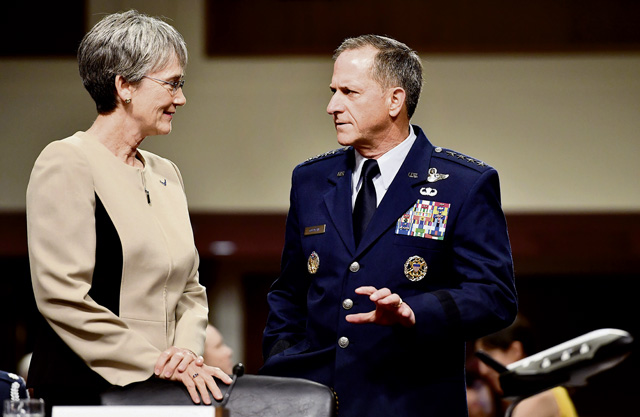
WASHINGTON (AFNS) —Secretary of the Air Force Heather Wilson and Air Force Chief of Staff Gen. David L. Goldfein testified before the Senate Armed Services Committee on Capitol Hill June 6.
At the forefront were the efforts to restore readiness and increase the lethality of the force. Wilson said any objective evaluation of today’s Air Force reaches two conclusions:
“The Air Force is too small for the missions demanded of it,” she said in advance of the hearing. “And adversaries are modernizing and innovating faster than we are, putting America’s technological advantage in air and space at risk.”
Air Force in demand
Looking forward, Wilson and Goldfein do not envision the demand for air and space power diminishing in the coming decade.
Today, the Air Force is manned with 660,000 active, guard, reserve and civilian Airmen, a 30 percent decline since Operation Desert Storm 26 years ago.
“We have the same level of taskings today as we did during Desert Storm,” Wilson said. “But we have 55 squadrons rather than 134.”
The Air Force leaders said while the fiscal 18 budget request focuses on restoring readiness and increasing lethality, future budgets must focus on modernization and continued readiness recovery.
Restoring readiness
The two testified that maintaining superiority starts with people.
“For an Airman, it’s nothing short of a moral obligation to gain and maintain air superiority,” Goldfein said. “This budget request begins to set the table for recovering and rebuilding our force.”
The fiscal 18 budget will bring the active duty force to 325,100 while also adding 800 reservists, 600 guardsman, and 3,000 civilians, bringing the total force to approximately 669,000. The increased manpower will focus primarily on increasing remotely piloted aircraft crews, maintainers, and pilot training capacity by adding two additional F-16 training squadrons and maximizing flying hours to the highest executable levels.
Wilson said next to people, the most obvious readiness need is munitions. In the fight against ISIS, the Air Force has delivered approximately 56,000 direct-attack munitions, more than it used in all of Operation Iraqi Freedom. The fiscal 18 budget funds maximum factory production of the most critical munitions.
Modernization
The fiscal 18 budget focuses on the Air Force’s top three modernization programs:
Purchasing 46 F-35A fighters and modernizing other fighters;
Buying 15 KC-46 tankers;
Funding the B-21 bomber development.
The proposed budget also supports the continuation and modernization of the nuclear triad with funds dedicated to both air- and ground-based capabilities.
Our nuclear enterprise is getting old and we must begin modernizing now to ensure a credible deterrent, Wilson said.
“Side-by-side with the United States Navy, we are responsible for two of the three legs of the nuclear Triad,” Goldfein said. “On our worst day as a nation, our responsibility is to ensure the president is where he needs to be, when he needs to be there, and he stays connected through command and control to the nuclear enterprise and for an Airman, that remains jobs one.”
Space
The Air Force has been the leading military service responsible for space for 54 years. Over the last several years, the service has been developing concepts for space control, changing the way it trains its space force and integrating space operations into the joint fight.
“We’ve provided GPS for the world. We’ve transformed not only the way we fight but the way all of you probably navigate around the city,” Wilson said. “We must expect that war, of any kind, will extend into space in any future conflict and we have to change the way we think and prepare for that eventuality.”
The proposed budget increases space funding by 20 percent, including a 27 percent increase in research, development, testing and evaluation for space systems, and a 12 percent increase for space procurement.
Innovation for the future
Research, development, testing and evaluation are critically important for the Air Force, Wilson and Goldfein said.
To prevail against rapidly innovating adversaries, the Air Force must accelerate procurement. The service will take advantage of authorities like the FY17 Defense Authorization Act to help get capabilities operational faster than ever before, Wilson said.
The request for funding for long-term research in air dominance increased significantly in the fiscal 18 budget. The Air Force will seek to increase basic and applied research in areas where it must maintain the competitive advantage over adversaries. This includes hypersonic vehicles, directed-energy, unmanned and autonomous systems, and nanotechnology.
“It’s going to take us approximately eight years to be able to get to full spectrum readiness with stable budgets,” Goldfein said. “We will be unable to execute the defense strategic guidance under sequester.”
“If the Budget Control Act limit isn’t fixed and we have to go through sequester, that will be equivalent to a $15 billion cut,” Wilson said. “We’re too small for what the nation expects of us now, sequestration would make the situation worse.”
According to Wilson and Goldfein, by supporting the budget request, Congress can provide fiscal predictability to the Air Force so it can continue to own the high ground, defend the homeland, and project power in conjunction with allies.


